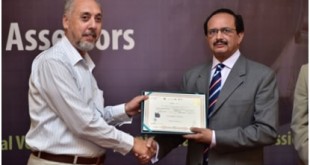What is the Competency Based Curricula Development Process?
Part of the answer lies in the question. How?
Let’s explain the question first, word by word. Words are concepts. Concepts have definitions. Therefore, definitions always make a good starting point.
Competence first: capacity to transfer knowledge and understanding into practice.
Curricula: teaching-learning content, structure and processes provided by teaching institutions and training institutes.
Development: a process for enabling the provision of competence to the labor market identified in a specific sector by following five distinct stages.
Process: it indicates that the competency based curricula development is not an accomplished fact. It is a process, changing and evolving because all five stages of curricula development are dynamic, interrelated and mutually responsive.
Well, it’s a fairly methodic process. In terms of inputs and outcomes it involves knowledge and practice, teaching and learning, structure and processes, teaching institutions and training institutes. In other words, the competency based curricula is a dynamic process based on a demand-led approach to skills development.
“Pakistan”, according to the National Skills Strategy 2009-2013, “follows a curriculum-based, time-bound approach. The rigidity of this approach makes it difficult for training programs to meet the skill needs of industry.”
 The national skill strategy document attributes the poor state of competency based training system in Pakistan to weak institutional linkages between government and industry. It out-rightly questions the quality and relevance of the existing training approach.
The national skill strategy document attributes the poor state of competency based training system in Pakistan to weak institutional linkages between government and industry. It out-rightly questions the quality and relevance of the existing training approach.
In order to bridge this gap it proposed to establish close liaison with industry to identify skills needs in their sectors, indicate new and emerging areas and occupations and determine and update competency standards for skilled workers”.
With the year 2013 fast approaching the end, one may ask that to what extent has the Islamic Republic of Pakistan internalized the demand-led approach for skills development. What has been done to create linkages between government and industry? It is important to ask these questions because the revised approach has major implications for all aspects of technical and vocational education and training (TVET).
 Muhammad Naeem Akhtar, Deputy National Leader TVET Reform Support Program, says that Pakistan has come a long way in pursuance of the goals set out by the National Skills Strategy. “Pakistan realizes the importance of this new training approach only to an extent,” he says adding that there is a consensus over Curriculum Development Guidelines by all the stakeholders. “But,” he adds, “in terms of outcomes we have still a long way to go”.
Muhammad Naeem Akhtar, Deputy National Leader TVET Reform Support Program, says that Pakistan has come a long way in pursuance of the goals set out by the National Skills Strategy. “Pakistan realizes the importance of this new training approach only to an extent,” he says adding that there is a consensus over Curriculum Development Guidelines by all the stakeholders. “But,” he adds, “in terms of outcomes we have still a long way to go”.
Naeem informs that all the provinces, following the National Skills Strategy, have prepared their own provincial Skill Action Plans for which TVET Reform Support Programme, co-funded by the European Union, the Kingdom of the Netherlands and the Federal Republic of Germany, is facilitating.
How come that there is still a long way to go? Naeem says explaining that the Labor Market Information (LMI) is just the first step in the process of competency based curricula development. “There is more about it; four stages follow LMI and these are; Job Analysis/DACUM, Standardization of Competences, Curricula Development, formulation of Industrial Advisory Groups and Sector Skills.”
Recall the question. What is the Competency Based Curricula Development Process?
The second part of the answer lies in Naeem’s explanation. How?
Let’s explain it by referring to five stages of the development process by listing particular inputs, outcomes and structures for each stage of the development.
Stage One: Input is the Collection and Analysis of Labor Market Information. Outcome is the Assessment of Capacity and Training Needs or a report which specifies demands for a specific sector and lists titles for the subject of the labor market demand analysis. It is structure through Labor Market Demand Analysis Groups.
Stage Two: Input is the Job Analysis. Output is a DACUM (Developing a Curriculum) chart which identifies the required skills, knowledge, understanding, tools, equipment, supplies and materials, future trends and issues, and workers’ traits and behaviors that are required. Outcomes of the DACUM chart are presented to the industry experts and sector skills experts of that particular sector to confirm the accuracy of the tasks, duties and other issues listed in the DACUM chart.
Stage Three: Following agreed procedures in order to develop competency-based curricula input in this stage is the analysis of tasks. Outcome is the definition of competency level for each task. That is the standard of performance an individual must achieve when carrying out a duty in the workplace, together with the relevant underpinning knowledge and understanding.
Stage Four: Input here is to develop specified curricula in draft and final form based on the criteria set by the National Vocational Qualifications Framework. In this process inputs/feedback is sought from the national curriculum development expert including Industrial Advisory Groups, key employers, sector skills experts and academicians.
Stage Five: In the final stage a review of outputs of DACUM charts, competency standards and curricula development is done in order to provide feedback and justifyreview points with experts for any recommended additions, deletions or major changes in the curricula upon implementation.
Having explained the concepts used in the above question and the processes that these concepts entail it may be said that it is this approach that defines and drives the process. Now, it may be useful to have an idea of the ways this process is being facilitated.
Highlighting the importance of the role played by TVET Reform Support Programme in driving and facilitating the process Muhammad Ali Khan, Communication Manager, TVET Reform Support Programme, says that the first important achievement was getting the National Curricula Template approved by the National Vocational and Technical Training Commission (NAVTTC). “Before this, there was no unified national template for curricula development,” Khan claims adding that as a result of the unified template a lot has been achieved.
“By the end of the Programme in 2015 we expect to develop 60 Competency Based Training programs for the Government of Pakistan,” he says listing the three priority sectors which include Energy, Service and Agriculture. “In the Agriculture sector, for example, we have already prepared curricula for cotton production and cotton processing separately. Likewise, the citrus and chili production/processing curricula have also been prepared. We hope to finalize it by the end of this year.”

“Secondly”, he stresses that, “it is important to acknowledge the facilitating role in involving the industry at different stages of the development process. For example, during the need assessment or when developing a DACUM, for making an outline of the curricula, to get the outline validated by the National Curricula Review Committee in which industry experts are also involved besides the training providers and academicians.”
Khan says that there are some trades for which curricula have been finalized but not notified. There are few trades for which curricula have been notified but not implemented yet. There are still others for which the curricula development processes are still underway. “In the Energy sector, for example, the first draft of the curricula for developing skills of Building Technicians in solar PV/ Panel installation and maintenance, has been completed. Similarly, the curricula for mechanics, technicians and plumbers wishing for overseas employment have also been completed.”
Experts believe that the need of the hour is to infuse life into TVET sector as it is of vital importance to address other challenges such as unemployment, poverty, the lack of access to health and educational facilities. The TVET Reforms Support Programme comes in the scene precisely to perform this task, that is, to facilitate the reform in TVET sector. This five-year Reform Support Program was launched in April 2011 to assist the Government of Pakistan in implementation of the National Skills Strategy.
 Pakistan TVET REFORM Support Programme Technical and Vocational Education and Training (TVET) Reform support Programme
Pakistan TVET REFORM Support Programme Technical and Vocational Education and Training (TVET) Reform support Programme






